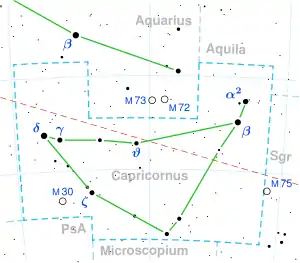 | |
| Observation data Epoch J2000.0 Equinox J2000.0 (ICRS) | |
|---|---|
| Constellation | Capricornus |
| Right ascension | 20h 51m 49.29095s[1] |
| Declination | −26° 55′ 08.8912″[1] |
| Apparent magnitude (V) | +4.11[2] |
| Characteristics | |
| Spectral type | K4 III[3] |
| U−B color index | +1.93[2] |
| B−V color index | +1.64[2] |
| Variable type | Suspected[4] |
| Astrometry | |
| Radial velocity (Rv) | +9.1±1.4[5] km/s |
| Proper motion (μ) | RA: −9.261[1] mas/yr Dec.: −1.598[1] mas/yr |
| Parallax (π) | 3.1381 ± 0.3711 mas[1] |
| Distance | approx. 1,000 ly (approx. 320 pc) |
| Absolute magnitude (MV) | −2.7[6] |
| Details | |
| Mass | 6.8±0.9[7] M☉ |
| Radius | 172.1+6.1 −12.0[1] R☉ |
| Luminosity | 6,269+826 −833[1] L☉ |
| Surface gravity (log g) | 0.85[8] cgs |
| Temperature | 3,915+138 −68[1] K |
| Metallicity [Fe/H] | −0.24[9] dex |
| Rotational velocity (v sin i) | 4.68[8] km/s |
| Age | 48.1±8.3[7] Myr |
| Other designations | |
| Database references | |
| SIMBAD | data |
Omega Capricorni, which is Latinized from ω Capricorni, is a star in the southern constellation Capricornus, near the southern constellation border with Microscopium. It is an orange hued star that is faintly visible to the naked eye, having an apparent visual magnitude of +4.11.[2] Based upon an annual parallax shift of 3.1 mas as seen from the Earth,[1] it is located approximately 1,000 light years from the Sun. It is a candidate member of the Ursa Major Moving Group[11] and has a relatively high peculiar velocity of 25.7±1.9 km/s, making it is a possible runaway star.[7]
In Chinese, 天田 (Tiān Tián), meaning Celestial Farmland, refers to an asterism consisting of ω Capricorni, 3 Piscis Austrini, 24 Capricorni and ψ Capricorni.[12] Consequently, the Chinese name for ω Capricorni itself is 天田二 (Tiān Tián èr, English: the First Star of Celestial Farmland.)[13]
This is an evolved K-type giant star with a stellar classification of K4 III,[3] and is a suspected variable.[4] With the supply of hydrogen at its core exhausted, the star has expanded to about 172[1] times the radius of the Sun. It is 48[7] million years old with 7 times the mass of the Sun.[7] Omega Capricorni is radiating 6,300[1] times the luminosity of the Sun from its bloated photosphere at an effective temperature of 3,915 K.[1] It is a barium star,[6] showing an overabundance of the s-process elements. This suggests that Omega Capricorni has an orbiting white dwarf companion.[14]
References
- 1 2 3 4 5 6 7 8 9 10 11 12 Brown, A. G. A.; et al. (Gaia collaboration) (August 2018). "Gaia Data Release 2: Summary of the contents and survey properties". Astronomy & Astrophysics. 616. A1. arXiv:1804.09365. Bibcode:2018A&A...616A...1G. doi:10.1051/0004-6361/201833051. Gaia DR2 record for this source at VizieR.
- 1 2 3 4 Nicolet, B. (1978), "Photoelectric photometric Catalogue of homogeneous measurements in the UBV System", Astronomy and Astrophysics Supplement Series, 34: 1–49, Bibcode:1978A&AS...34....1N.
- 1 2 Houk, Nancy (1979), Michigan catalogue of two-dimensional spectral types for the HD stars, vol. 3, Ann Arbor, Michigan: Dept. of Astronomy, University of Michigan, Bibcode:1982mcts.book.....H.
- 1 2 NSV 13351, American Association of Variable Star Observers, retrieved 2017-05-07.
- ↑ Gontcharov, G. A. (November 2006), "Pulkovo Compilation of Radial Velocities for 35 495 Hipparcos stars in a common system", Astronomy Letters, 32 (11): 759–771, arXiv:1606.08053, Bibcode:2006AstL...32..759G, doi:10.1134/S1063773706110065, S2CID 119231169.
- 1 2 Mennessier, M. O.; et al. (October 1997), "Barium stars, galactic populations and evolution.", Astronomy and Astrophysics, 326: 722–730, Bibcode:1997A&A...326..722M.
- 1 2 3 4 5 Tetzlaff, N.; Neuhäuser, R.; Hohle, M. M. (January 2011), "A catalogue of young runaway Hipparcos stars within 3 kpc from the Sun", Monthly Notices of the Royal Astronomical Society, 410 (1): 190–200, arXiv:1007.4883, Bibcode:2011MNRAS.410..190T, doi:10.1111/j.1365-2966.2010.17434.x, S2CID 118629873.
- 1 2 Hekker, S.; Meléndez, J. (December 2007), "Precise radial velocities of giant stars. III. Spectroscopic stellar parameters", Astronomy and Astrophysics, 475 (3): 1003–1009, arXiv:0709.1145, Bibcode:2007A&A...475.1003H, doi:10.1051/0004-6361:20078233, S2CID 10436552.
- ↑ McWilliam, Andrew (1990), "High-resolution spectroscopic survey of 671 GK giants. I - Stellar atmosphere parameters and abundances", The Astrophysical Journal Supplement Series, 74: 1075, Bibcode:1990ApJS...74.1075M, doi:10.1086/191527.
- ↑ "ome Cap". SIMBAD. Centre de données astronomiques de Strasbourg. Retrieved 2017-05-07.
- ↑ Chupina, N. V.; et al. (June 2006), "Kinematic structure of the corona of the Ursa Major flow found using proper motions and radial velocities of single stars", Astronomy and Astrophysics, 451 (3): 909–916, Bibcode:2006A&A...451..909C, doi:10.1051/0004-6361:20054009. See table 7.
- ↑ (in Chinese) 中國星座神話, written by 陳久金. Published by 台灣書房出版有限公司, 2005, ISBN 978-986-7332-25-7.
- ↑ (in Chinese) AEEA (Activities of Exhibition and Education in Astronomy) 天文教育資訊網 2006 年 7 月 3 日
- ↑ Gomez, A. E.; et al. (1997), "Absolute magnitudes and kinematics of barium stars", Astronomy and Astrophysics, 319: 881, Bibcode:1997A&A...319..881G.